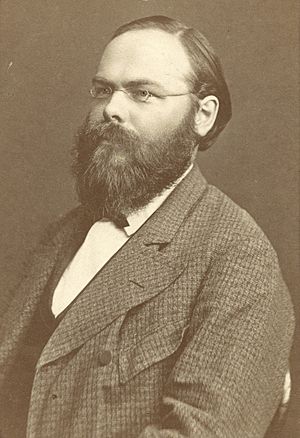Hermann Schwarz facts for kids
Quick facts for kids
Hermann Schwarz
|
|
|---|---|

Karl Hermann Amandus Schwarz
|
|
| Born | 25 January 1843 Hermsdorf, Silesia, Prussia
|
| Died | 30 November 1921 (aged 78) |
| Nationality | Prussian |
| Alma mater | Gewerbeinstitut |
| Known for | Cauchy–Schwarz inequality |
| Scientific career | |
| Fields | Mathematician |
| Institutions | University of Halle Swiss Federal Polytechnic Göttingen University |
| Doctoral advisor | Karl Weierstrass Ernst Kummer |
| Doctoral students | Lipót Fejér Harris Hancock Gerhard Hessenberg Paul Koebe Leon Lichtenstein Heinrich Maschke Robert Remak Rudolf Rothe Theodor Vahlen Ernst Zermelo |
Karl Hermann Amandus Schwarz (born January 25, 1843 – died November 30, 1921) was an important German mathematician. He is famous for his work in a field of math called complex analysis. This area of math deals with numbers that have both a real and an imaginary part.
Life of Hermann Schwarz
Hermann Schwarz was born in Hermsdorf, a place in Silesia. This area is now part of Poland. In 1868, he married Marie Kummer. Marie was the daughter of another famous mathematician, Ernst Eduard Kummer.
Hermann and Marie had six children together. One of their daughters was named Emily Schwarz.
Schwarz first started studying chemistry in Berlin. However, two well-known mathematicians, Ernst Eduard Kummer and Karl Weierstrass, convinced him to switch to mathematics. He earned his Ph.D. from the University of Berlin in 1864. His advisors were Kummer and Weierstrass.
From 1867 to 1869, he worked at the University of Halle. After that, he moved to the Swiss Federal Polytechnic in Zurich. In 1875, he began working at Göttingen University. There, he focused on complex analysis, differential geometry, and the calculus of variations. He passed away in Berlin.
Hermann Schwarz's Work and Discoveries
Schwarz wrote many important mathematical papers. One of his famous works is called Bestimmung einer speziellen Minimalfläche. This paper was recognized by the Berlin Academy in 1867. He also published his collected mathematical works in 1890.
Schwarz made several key contributions to mathematics. He improved the proof of the Riemann mapping theorem. This theorem is about how different shapes can be mapped onto each other in complex analysis.
He also developed a special version of the Cauchy–Schwarz inequality. This is a very important inequality used in many areas of mathematics. Schwarz also proved that a ball has the smallest surface area compared to any other object with the same volume. This is part of the isoperimetric inequality.
His work on shapes and volumes helped another mathematician, Émile Picard. Picard used Schwarz's ideas to show that solutions to certain differential equations exist. These are equations that involve rates of change.
In 1892, Schwarz became a member of the Berlin Academy of Science. He also became a professor at the University of Berlin. Many students learned from him there. Some of his notable students included Lipót Fejér, Paul Koebe, and Ernst Zermelo. He guided at least 22 students to earn their Ph.D. degrees.
In 1914, Schwarz's friends and former students celebrated the 50th anniversary of his doctoral degree. They published a special book with 34 articles in his honor.
Many mathematical ideas and concepts are named after Hermann Schwarz. These names show how much his work influenced the field. Some of these include:
- Cauchy–Schwarz inequality
- Schwarz alternating method
- Schwarz function
- Schwarz lemma
- Schwarz reflection principle
- Schwarz triangle
See also
 In Spanish: Hermann Schwarz para niños
In Spanish: Hermann Schwarz para niños

